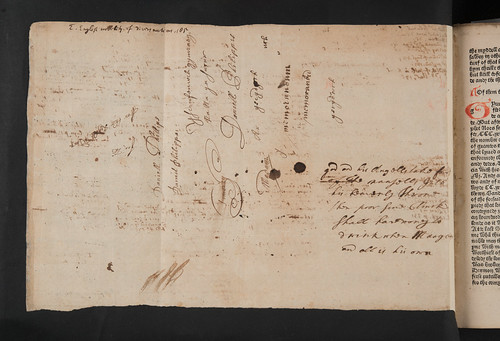Higden, Ranulphus: The description of Britain.
Extracted from the Polychronicon of Ranulph Higden, in the translation of Johannes de Trevisa. Edited by William Caxton.
Westminster: William Caxton, 18 Aug. 1480.
Fol. [1-38 46]. [30] leaves (4/6 blank).
ISTC ic00477000; GW 6670 (II); Goff C477; BMC XI 118 (IB. 55028); Bod-inc C-194; DeR(C) 35.12.
| GIP number: | H27 |
| Shelf-mark: | Sp Coll Hunterian Bv.2.31 (see main library entry for this item) |
| Variant: | 4/5r (f. 29r), line 13: “... endeth het ...” as BMC, not as GW (II) “... endeth the ...”; 4/5r, line 19: “... therfore ...” as BMC, not as GW (II) “... therefore ...”; 4/5r, line 20: “... whiche atte requeſt ...” as BMC, not as GW (II) “which atte requeſte ...” |
| Note: | Inserted at the front of the volume, between the first and second flyleaves, is the lower half of leaf Aaaij from a copy of Bartolus de Saxoferrato, Super secunda parte Digesti novi, cum additionibus Alexandri Tartagni. [Lyons: Johannes Siber, ca. 1495] (ISTC ib00223300); see http://daten.digitale-sammlungen.de/~db/0007/bsb00071237/images/index.html?id=00071237&fip=xsyztsxsqrsyztsenxdsydxdsydw&no=25&seite=387. |
| Bound with: | Bound before Chronicles of England. Westminster: William Caxton, 10 June 1480 (C35). BMC, De Ricci, STC, Rhodes (Oxford Colleges) treat the Higden and the Chronicles of England as two separate items, though “Caxton obviously aimed to sell these works together” - see BMC XI 117; ISTC, Goff, and Bod-inc treat them as a single item. |
| Provenance: | John Jewel(?) of Northcott, Devon (d. 1589): inscription in the margin of the incunable leaf (see Note above) inserted at the front “diem clausit extremu[m] Joh[ann]es Jule [Jewel?] de Northcott [...] obijt vijo [scored through] octauo die augustij anno d[omi]ni Mo Dlxxxixo annoque d[omi]ne [...] Elizabeth Regine nunc angl[iae] tricesimo primo et sepult[us] fuit in eccl[es]ia p[ar]ochialis de Estdowne [East Down] x die eiusd[e]m men[sis”; followed by an annotation in a 17th-century hand “The fyne exemplified. The feofment of my fathers land. The fyne of northcott ...” William Turton (17th/18th century): inscription on second front flyleaf “Will: Turton [id est] ex bibl. D. Owen”; name on b3r of Chronicles of England “Will. Turton”. D. Owen (17th/18th century): see above. Daniel Phillips (17th/18th century): inscriptions ‘Daniell Phillips’, ‘Daniel Philippes’, and ‘Daniell Philippes’ followed by words in Welsh ‘Yscrufenwch gymraeg na na yn (?)sutur’; these appear on a folded sheet of paper containing a 17th/18th-century manuscript index to the second work in the volume, Chronicles of England, which is inserted between 3/8 and 4/1 (ff. 24 and 25). William Hunter (1718-1783), physician and anatomist: source unknown. University of Glasgow: Hunterian bequest 1807; Hunterian Museum bookplate on front pastedown, with former shelfmark “B.9.2”. |
| Binding: | England, full dark brown goatskin; rebound and given new pastedowns by Douglas Cockerell and Son, Mar. 1962; replacing an 18th-century quarter sheep binding with marbled paper sides; binder’s note tipped onto rear free endpaper; samples of original marbled paper sides and lettering piece mounted on new rear pastedown. Size: 254 x 188 mm. |
| Leaf size: | 243 x 172 mm. |
| Annotations: | Marginal annotations in English, underlining and manicules in a 17th/18th-century hand, including annotations at the beginning of chapter xvi (‘Of the londe of Wales’) ‘This is the ancient Saxon kind of poetry’ and ‘English poetry in the time of Edw. 6. How much amended since’. Lengthy annotations after the colophon, relating to Caxton and the art of printing, and to Ranulphus Higden. A list of place names or properties in Devon (e.g. Raleigh, ‘Patehehoole’ ie. Patehole, ‘Trynshoo’ i.e. Trentishoe) in a 16th-century hand on recto of second front flyleaf accompanied by sums of money (perhaps amercements or rents?). 17th/18th-century note on John de Trevisa on the same page together with several quotations or mottoes: ‘Tenet insanabile multos scribendi cacoethes’ (Juvenal, Satires, VII, 51-2), ‘Scribimus docti indoctique’ (Horace, Epistles, II, 95-6), ‘Nescire quid antea quam natus sis acciderit, id est semper esse puerum’ (Cicero, De oratore, 34, 10, and ‘ὃργανον τῆς παιδείας οὐκ ᾑ κτῆσις, ἀλλ’ ᾑ χρῆσις των βιβλίων’ (Plutarch, De liberis educandis, 8) - the latter with the date 1706 added. On verso of second front flyleaf is a note ‘The Saxon letters wch differ from ye Vulgar’ followed by a list of ten letters |
| Decoration: | Initials and paragraph marks supplied in red. |
| Imperfections: | Wanting 1/1-2; 1/3-4 mutilated, with loss of text. |






